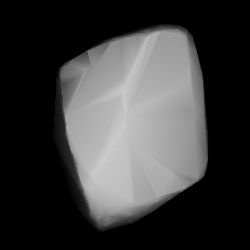Top Qs
Timeline
Chat
Perspective
1237 Geneviève
Main-belt asteroid From Wikipedia, the free encyclopedia
Remove ads
1237 Geneviève (prov. designation: 1931 XB) is a background asteroid from the central region of the asteroid belt, approximately 38 kilometers (24 miles) in diameter. It was discovered on 2 December 1931, by French astronomer Guy Reiss at the Algerian Algiers Observatory in North Africa.[3] The discoverer named it after his daughter Geneviève Reiss.[2]
Remove ads
Orbit and classification
Geneviève is a non-family asteroid of the main belt's background population when applying the hierarchical clustering method to its proper orbital elements.[4][5] It orbits the Sun in the central main-belt at a distance of 2.4–2.8 AU once every 4 years and 3 months (1,542 days). Its orbit has an eccentricity of 0.08 and an inclination of 10° with respect to the ecliptic.[1]
In 1908, it was first identified as A908 HA at Taunton Observatory (803). A few days later, Geneviève was also observed at the U.S. Naval Observatory, which extended the body's observation arc by 23 years prior to its official discovery observation at Algiers.[3]
Remove ads
Naming
This minor planet was named for the eldest daughter of the discoverer, Geneviève Reiss. The discoverer also named 1300 Marcelle and 1376 Michelle after his other two daughters. The official naming citation was mentioned in The Names of the Minor Planets by Paul Herget in 1955 (H 114).[2]
Physical characteristics
In May 1984, American astronomer Richard Binzel obtained a rotational lightcurve of Geneviève that gave a rotation period of 16.37 hours with a brightness variation of 0.23 magnitude (U=2).[12] A divergent period of 24.82 hours with an amplitude of 0.07 magnitude was obtained from photometric observations by astronomer Raymond Poncy in April 2005 (U=2-).[13]
Physical characteristics
According to the surveys carried out by the Infrared Astronomical Satellite IRAS, the Japanese Akari satellite, and NASA's Wide-field Infrared Survey Explorer with its subsequent NEOWISE mission, Geneviève measures between 30.85 and 40.67 kilometers in diameter, and its surface has an albedo between 0.057 and 0.07 (without preliminary results).[9][10][11]
The Collaborative Asteroid Lightcurve Link (CALL) agrees with the results obtained by IRAS, and derives an albedo of 0.0484 and a diameter of 39.74 kilometers using an absolute magnitude of 10.91.[8]
Remove ads
References
External links
Wikiwand - on
Seamless Wikipedia browsing. On steroids.
Remove ads

